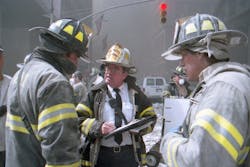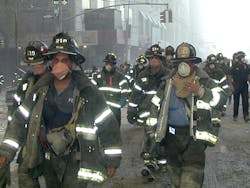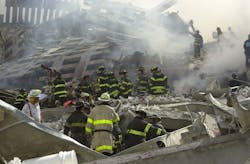The events of Sept. 11, 2001, resulted in the loss of several of the senior executive leaders in the FDNY. Among those killed were First Deputy Fire Commissioner William Feehan, Chief of Department Peter Ganci Jr., Assistant Chief Gerard Barbara and Assistant Chief Donald Burns.
All of these men were highly respected, and their loss created a serious leadership vacuum for our department. In addition to these four executives, we lost several senior deputy chiefs and battalion chiefs, including Chief of Special Operations Raymond Downey. The department’s Special Operations Command was affected particularly negatively as a result of the loss of almost 20 percent of its members, including chiefs, company officers and firefighters. (The FDNY has a uniformed workforce of approximately 15,000 firefighters and EMS members.)
I was a relatively new battalion chief at the time of the terrorist attacks. The department’s continuity of operations plan allowed us to fill the gaps initially, but the many years of experience that were lost surely would be difficult to replace.
The new Chief of Department (now Fire Commissioner) Daniel Nigro and then-Fire Commissioner Thomas VonEssen were confronted with a significant challenge in the face of the massive rescue and recovery effort that was being undertaken at the World Trade Center site.
In January 2002, Mayor Michael Bloomberg appointed a new Fire Commissioner, Nicholas Scoppetta. Chief Nigro selected Salvatore Cassano as the new chief of operations. After the conclusion of the rescue and recovery operation, many senior members retired, which created even more of a leadership and experience hurdle. We needed to begin to rebuild with strength and resilience.
How could the FDNY meet the challenge successfully? I argue that the basic tenets of leadership were the keys to success.
Being a leader in the fire and EMS service is a difficult mission. Leadership is a critical component of being a successful chief and company officer. This became even more evident after 9/11. Those who step forward and take on the challenge often face many questions, and I would argue that a critical self-assessment is a key part of the leadership process. This is true organizationally and individually.
The senior chiefs who began to fill the leadership vacuum are too many to name here, but suffice it to say, their dedication, perseverance and work ethic will be remembered throughout the history of the FDNY.
All of the chiefs who were assigned the responsibility of rebuilding the FDNY had great reputations as leaders. There was a sense of confidence from the rank and file. After understanding the leader’s intent from the new fire commissioner and chief of department, these people were able to begin the task of rebuilding. This was a truly collective effort that involved people at all levels of the department.
Leader’s intent is critical to achieving success. It defines the vision for the unit, company or department, and it complements expectations. The troops must know the expectations: If they know the expectations, they will be more willing to work with you and for you in accomplishing the mission. The role of leader’s intent is to empower subordinates and instill initiative so that they can adapt to the environment that they are in.
This was never more important than in the aftermath of 9/11. The key to sharing leader’s intent is having the ability to show command presence. Our leaders did that well. They communicated effectively, and their command presence resulted in a shared confidence. If the troops have confidence in their leaders, they will perform to the best of their ability.
Of course, there is no magic formula to developing command presence, but not having it negatively affects any individual’s ability to lead.
In his classes, Burns defined leadership simply: Leadership is the ability to influence people. Trust is the key to having the ability to influence. He would explain that we, particularly those who are in the fire and EMS services, trust people who are of good character and are competent in their job. If you build a high level of trust in subordinates, they will follow where you want them to go.
Research of leadership attributes identifies critical qualities that can better define a leader. People who we trust are of good character and competent. They are honest and have integrity. They are confident, inspiring, motivating, forward-thinking and proactive. These principles are key to being successful leaders. Our department’s leadership after 9/11 exemplified character and competence.
Leadership is difficult and requires courage as well. Martin Luther King Jr. said, “The ultimate measure of a man is not where he stands in moments of comfort and convenience, but where he stands at times of challenge and controversy.” General (Ret.) Stanley McChrystal (U.S. Army) said, “Leaders can let you fail and yet not let you be a failure.”
Challenge yourself. Lead from the front. Share your vision as a leader.
Command philosophy
What is a philosophy? In simple terms, we might describe it as a set of beliefs, values and principles that strongly influences how we interpret reality and that guides our understanding of how to influence humans. The development of a solid command philosophy helps to guide us in shaping and influencing our organizations in a positive way.
After 9/11, our leadership had the challenging mission of rebuilding the FDNY stronger, with more capabilities, despite having suffered a significant loss of talent and experience. It took several years through hard work, painstaking planning and sheer determination. We enhanced training to include an all-hazards approach to preparedness, replaced and upgraded a fleet of apparatus, and upgraded our communications and technology infrastructure. All of this occurred as a result of a commitment from our political leaders and senior executives as they worked collaboratively.
Most importantly, our fire operations and EMS operations personnel throughout the past 20 years continue to stay focused on the mission of saving lives.
Rebuilding after 9/11 & Core Values
In addition to great leadership and a core command philosophy, adhering to the FDNY’s core values was very important in rebuilding the department after 9/11. Here are the core values, as they are defined in department documents:
- Service: The FDNY continues its unwavering commitment to protect and serve.
- Bravery: Courage is the foundation of our character. Bravery is the ability to overcome fear through fortitude, instinct, compassion for others and training.
- Safety: Our citizens must be reasonably free from danger, especially deliberate, harmful acts. With the best equipment and training, the FDNY can reduce risk to the public and its members at fires, emergencies and medical incidents.
- Honor: The enormous commitment necessary to perform the FDNY tasks requires excellence of character. We inspire each other through pride in our unit, which is a belief that every action reflects on all the members of the unit, both past and present.
- Dedication: A commitment to the objectives of our mission is an essential part of our code of conduct. The faithful observance of duty calls for us to fulfill our obligations professionally and honestly.
- Preparedness: By combining all the components of our core values, the FDNY will maintain its constant state of readiness to meet all threats and challenges, traditional and new.
About the Author
Thomas Richardson
Thomas Richardson was appointed to the FDNY in November 1980. He has been a chief officer since September 2000. Richardson was designated as Chief of the Fire Academy in April of 2017 and then Chief of Training in 2018. In February 2019, he was appointed as the Chief of Fire Operations, until his promotion to Chief of Department on June 26, 2021. Richardson's undergraduate degree is from SUNY Empire State College. He received a Master of Arts degree in security studies from the Center for Homeland Defense and Security at the Naval Postgraduate School and has attended the Columbia University Fire Officers Management Institute and the Combating Terrorism Center at West Point.



